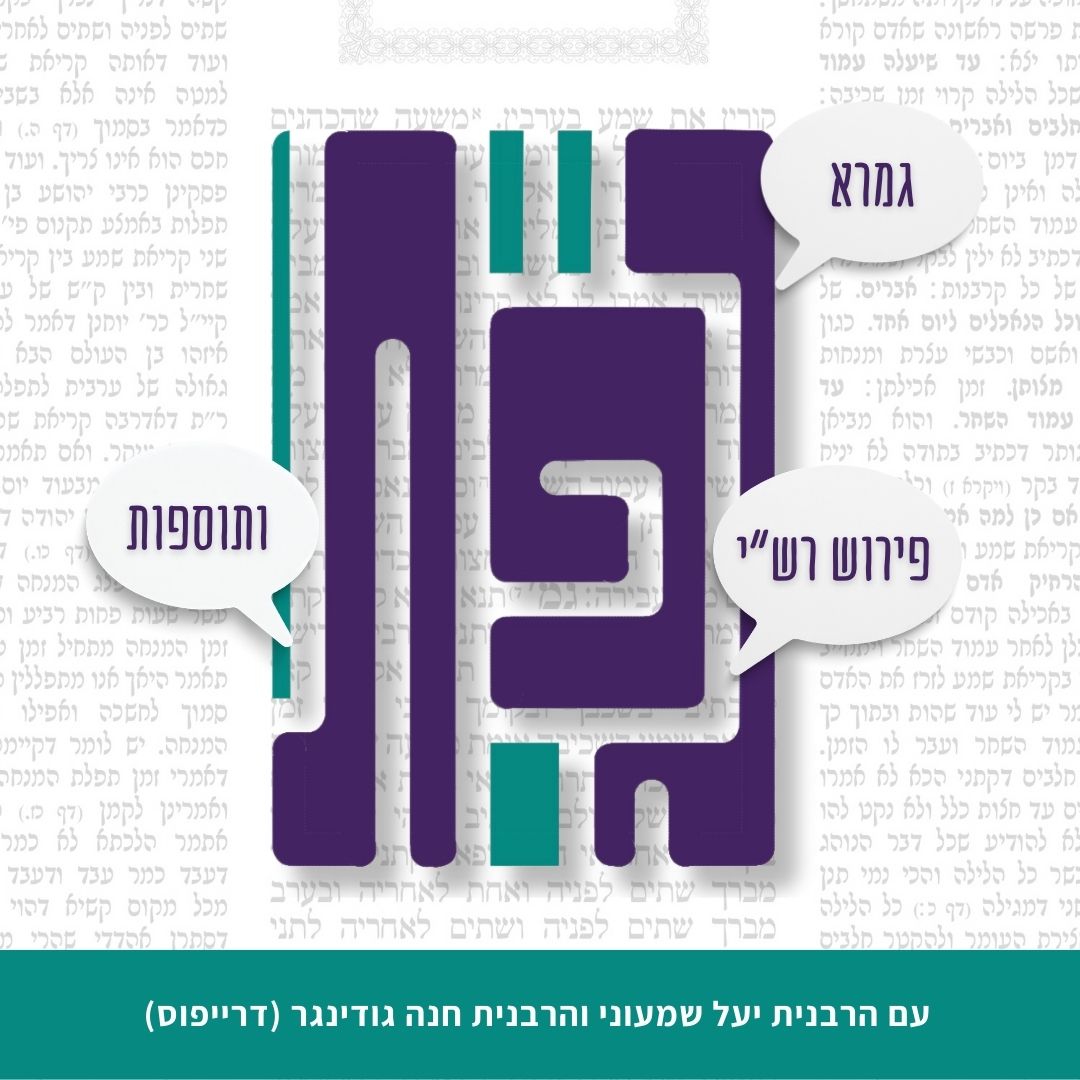From where do we derive that undomesticated animals are included in the term for domesticated animals and the reverse – what is the relevance in halacha? From where do we derive that impurity inside someone’s body does not pass on impurity and does not become impure?
This month’s learning is sponsored by Beth Balkany in honor of their granddaughter, Devorah Chana Serach Eichel. “May she grow up to be a lifelong learner.”
Want to dedicate learning? Get started here:


This month’s learning is sponsored by Beth Balkany in honor of their granddaughter, Devorah Chana Serach Eichel. “May she grow up to be a lifelong learner.”
Delve Deeper
Broaden your understanding of the topics on this daf with classes and podcasts from top women Talmud scholars.
New to Talmud?
Check out our resources designed to help you navigate a page of Talmud – and study at the pace, level and style that fits you.
The Hadran Women’s Tapestry
Meet the diverse women learning Gemara at Hadran and hear their stories.
Chullin 71
בהמה טמאה בכלל חיה טמאה בהמה טהורה בכלל חיה טהורה ובלשון הזה אמר לי חבל על בן עזאי שלא שימש את רבי ישמעאל
And likewise, a non-kosher behema is included in the category of a non-kosher ḥayya, and a kosher behema is included in the category of a kosher ḥayya. Accordingly, although the verse here is referring to a behema, it is understood to be referring collectively to both a behema and a ḥayya, and teaches that the carcasses of both types impart impurity. And upon hearing this, ben Azzai said to me in these words: Woe [ḥaval] unto ben Azzai, who did not serve Rabbi Yishmael.
חיה בכלל בהמה מנלן דכתיב (דברים יד, ד) זאת הבהמה אשר תאכלו שור שה כשבים וגו’ איל וצבי ויחמור וגו’ הא כיצד חיה בכלל בהמה
The Gemara analyzes Rabbi Yishmael’s statement: From where do we derive that according to the Torah, a ḥayya is included in the category of a behema? As it is written: “These are the behema that you may eat: An ox, a sheep, and a goat, a deer, and a gazelle, and a fallow deer, and a wild goat, and an oryx, and an aurochs, and a wild sheep” (Deuteronomy 14:4–5). Despite employing the term “behema,” the verse also lists the deer and the gazelle, which are undomesticated animals. How is this possible? From here it is evident that a ḥayya is included by the Torah in the category of a behema.
בהמה בכלל חיה מנלן דכתיב (ויקרא יא, ב) זאת החיה אשר תאכלו מכל הבהמה אשר על הארץ כל מפרסת פרסה הא כיצד בהמה בכלל חיה
From where do we derive that according to the Torah, a behema is included in the category of a ḥayya? As it is written: “These are the ḥayya that you may eat, among all the behema that are on the earth. Whatever parts the hoof” (Leviticus 11:2–3). How is this possible, that the verse mentions a ḥayya and then refers to a behema? This indicates that a domesticated animal is included in the category of a ḥayya by the Torah.
חיה טהורה בכלל בהמה טהורה לסימנים
The Gemara further clarifies: The principle that a kosher ḥayya is included by the Torah in the category of a kosher behema is relevant with regard to the distinguishing characteristics of kosher animals. The Torah states with regard to a domesticated animal that only a species that chews its cud and has cloven hooves is kosher. Nevertheless, this requirement is understood as a reference to both domesticated and undomesticated animals.
חיה טמאה בכלל בהמה טמאה להרבעה
The principle that a non-kosher ḥayya is included by the Torah in the category of a non-kosher behema is relevant with regard to the prohibition against mating one species with another. The Torah states the prohibition with regard to a behema: “You shall not let your animal [behema] mate with a diverse kind” (Leviticus 19:19). Nevertheless, this is understood as referring to both a behema and a ḥayya.
בהמה טמאה בכלל חיה טמאה לכדרבי דתניא
The principle that a non-kosher behema is included by the Torah in the category of a non-kosher ḥayya is relevant with regard to that which Rabbi Yehuda HaNasi taught, as it is taught in a baraita: The verse delineates a case in which one is obligated to bring a sliding-scale offering as an atonement: “A person who touched anything impure, or the carcass of a non-kosher undomesticated animal [ḥayya], or the carcass of a non-kosher domesticated animal [behema], or the carcass of an impure creeping animal, and is guilty, it having being hidden from him that he is impure” (Leviticus 5:2). But the nature of the transgression for which the person requires atonement is not apparent from the verse.
רבי אומר אקרא אני חיה בהמה למה נאמרה
Rabbi Yehuda HaNasi says: Since a domesticated animal is also referred to as a ḥayya, it would be sufficient if I would read, i.e., the verse would write, only the clause about a ḥayya, and I would have known that one who touches a carcass of any non-kosher animal is impure. Why, then, is an explicit clause about a behema stated? It serves as the basis for a verbal analogy.
נאמרה כאן בהמה טמאה ונאמר להלן בהמה טמאה מה להלן טומאת קדש אף כאן טומאת קדש
It is stated here, with regard to one who is unaware that he touched an impure item: “Non-kosher behema,” and it is likewise stated below, with regard to one who was aware that he touched an impure item: “Non-kosher behema,” in the following verse: “And when any one shall touch any impure thing, whether it is the impurity of man, or a non-kosher behema, and then eats of the flesh of a peace offering to the Lord, that soul shall be cut off from its people” (Leviticus 7:21). Just as below, the verse is referring to the defiling of sacrificial foods, so too here, the reference is to the defiling of sacrificial foods, and therefore one must bring a sliding-scale offering as an atonement.
בהמה טהורה בכלל חיה טהורה ליצירה דתנן המפלת מין בהמה חיה ועוף בין טמאין בין טהורין אם זכר תשב לזכר
The Gemara clarifies the final statement: The principle that a kosher behema is included by the Torah in the category of a kosher ḥayya is relevant with regard to the formation of children. As we learned in a mishna (Nidda 21a): With regard to a woman who miscarries a fetus that appears to be in the form of a type of behema, ḥayya, or bird, whether it had the form of a non-kosher species or a kosher species, if the fetus is a male, then she observes the periods of impurity and purity required for giving birth to a male.
אם נקבה תשב לנקבה
The mishna continues: And if the fetus is a female, then she observes the periods required for giving birth to a female. After giving birth to a male, a woman is impure for seven days, during which it is prohibited for her to engage in intercourse. During the next thirty-three days she may immerse in a ritual bath at any time, after which she is permitted to engage in intercourse even should she then experience a discharge of uterine blood. Nevertheless, during the entire forty-day period she may not enter the Temple or be in contact with consecrated foods. After giving birth to a girl, the length of each of these periods is doubled to fourteen days and sixty-six days, respectively (see Leviticus 12:2–5).
אינו ידוע תשב לזכר ולנקבה
If the sex of the fetus is unknown, she observes the strictures of a woman who gave birth both to a male and to a female. Accordingly, it is prohibited for her to engage in intercourse for the fourteen days after birth, after which she immerses in a ritual bath. After that she is permitted to engage in intercourse despite any discharge of uterine blood until the fortieth day after birth, i.e., for thirty-three days following the seven days she would have been prohibited from engaging in intercourse if the fetus was male. The prohibition against entering the Temple, however, continues until eighty days have passed from the birth.
דברי רבי מאיר
This is the statement of Rabbi Meir. The Gemara elsewhere (Nidda 22b) explains that Rabbi Meir derives his opinion from the fact that the term “formation” is used to describe both the formation of man: “Then the Lord God formed man” (Genesis 2:7), and the formation of animals and birds: “The Lord God formed every animal [ḥayya] of the field, and every bird of the air” (Genesis 2:19). Furthermore, he holds that the term “ḥayya” is referring to both domesticated and undomesticated animals, and concludes that a woman observes these periods of purity and impurity if the fetus has the form of any of these types of animals.
וחכמים אומרים כל שאינו מצורת אדם אינו ולד
And the Rabbis say: Any fetus that is not of human form is not regarded as an offspring with regard to observance of these periods of purity and impurity, and she is permitted to engage in intercourse provided she does not experience a discharge of uterine blood.
ולרבנן האי קרא למה לי
§ The Gemara returns to explaining the opinion of the Rabbis, cited in the mishna, who hold that a dead fetus found inside its mother’s womb does not impart impurity, irrespective of whether it is of a kosher or a non-kosher animal. Rabbi Yosei HaGelili disagrees and holds that a dead fetus inside a non-kosher animal imparts impurity. He derives this from the verse: “A person who touched anything impure, or the carcass of a non-kosher ḥayya, or the carcass of a non-kosher behema, or the carcass of an impure creeping animal, and is guilty” (Leviticus 5:2), which is referring only to non-kosher animals. The Gemara asks: And according to the Rabbis, why do I need this verse?
כוליה לכדרבי הוא דאתא:
The Gemara answers: The entire verse comes to teach that which Rabbi Yehuda HaNasi taught in the baraita cited earlier, that the verse obligates one to bring a sliding-scale offering only in cases where one partook of consecrated foods or entered the Temple while in a state of impurity of which one was unaware.
מתני׳ האשה שמת ולדה בתוך מעיה ופשטה חיה את ידה ונגעה בו החיה טמאה טומאת שבעה והאשה טהורה עד שיצא הולד:
MISHNA: With regard to a woman whose fetus died in her womb and the midwife extended her hand into the womb and touched the fetus, the midwife is thereby rendered impure with the seven-day impurity imparted by a corpse, and the woman remains ritually pure until the offspring emerges from the womb.
גמ׳ אמר רבה כשם שטומאה בלועה אינה מטמאה כך טהרה בלועה אינה מיטמאה
GEMARA: Rabba says: Just as a ritually impure item that is encapsulated within a body does not impart impurity to an item that comes in contact with it, so too, a ritually pure item that is encapsulated within a body cannot be rendered impure if it comes in contact with an impure item. For example, if one swallowed a ring that was ritually pure and then entered a tent containing a corpse, the ring would not be rendered impure.
טומאה בלועה מנלן דכתיב (ויקרא יא, מ) והאוכל מנבלתה יכבס בגדיו מי לא עסקינן דאכל סמוך לשקיעת החמה וקאמר רחמנא טהור
The Gemara asks: From where do we derive that an encapsulated impure item does not impart impurity? As it is written: “And one who eats of its carcass shall wash his clothes, and be impure until the evening” (Leviticus 11:40), i.e., he must immerse his body and garments in a ritual bath, and he then becomes pure at sunset. Are we not dealing even with a case where one ate from the carcass close to sunset and then immersed? And yet the Merciful One states that he is pure once the sun sets, despite the fact that his stomach still contains pieces of the carcass that have not yet been digested. If so, it is apparent that an encapsulated impure item does not impart impurity.
ודלמא שאני התם דלא חזיא לגר
The Gemara challenges: But perhaps it is different there, as with regard to the prohibition against eating a carcass the Torah states: “You shall not eat any carcass; you may give it to the gentile resident who is in your cities” (Deuteronomy 14:21). The juxtaposition of the two parts of the verse teaches that the prohibition is limited to a carcass that is fit to be given to a gentile resident, i.e., it is fit for human consumption. Accordingly, perhaps the carcass that the person ate does not impart impurity, as it is no longer fit for a gentile resident, i.e., it is now unsuitable for human consumption.
הניחא לרבי יוחנן דאמר אחת זו ואחת זו עד לכלב שפיר
The Gemara comments that the effectiveness of the proof depends on whether a carcass can impart impurity to a person despite its not being fit for human consumption: This proof works out well according to the opinion of Rabbi Yoḥanan, who says: A carcass imparts impurity to both this, a person, and that, food, even if it is unfit for human consumption, until it is no longer fit for consumption by a dog. According to this opinion the proof is understood well, as the carcass in the person’s stomach still has the ability to impart impurity to him because it is still fit for consumption by a dog. Therefore, it is apparent that the only reason it does not impart impurity is that it is encapsulated within his body.
אלא לבר פדא דאמר טומאה חמורה לגר וטומאה קלה עד לכלב משום דלא חזיא לגר הוא
But according to the opinion of bar Padda, who says a carcass has the severe form of ritual impurity, which can impart impurity to people only while it is still fit to be eaten by a gentile resident and it has the light form of ritual impurity even until the point that it is no longer fit for consumption by a dog, this proof is flawed. This is because it is possible the carcass in the person’s stomach does not render him impure simply because it is no longer fit for human consumption. Can one claim that the carcass cannot impart impurity because it is no longer fit for a gentile resident?
נהי דלא חזיא בפניו שלא בפניו מיחזיא חזיא ליה
Granted that the carcass is not fit to be eaten by someone when it was eaten in his presence, as he is aware that it was swallowed and considers it disgusting to eat a swallowed item, but it is still sometimes fit for a person to eat when it was eaten not in his presence and he is unaware that it had been previously swallowed. This is possible where one consumed a small piece of food and did not chew it prior to swallowing. The Gemara concedes this point and therefore accepts the proof.
אשכחן טומאה בלועה טהרה בלועה מנלן
The Gemara asks: We found a source for the halakha that an encapsulated impure item does not impart impurity. From where do we derive that a pure item that is encapsulated within another body cannot be rendered impure if it comes in contact with an impure item?
קל וחומר ומה כלי חרס המוקף צמיד פתיל שאינו מציל על טומאה שבתוכו מלטמא דאמר מר טומאה רצוצה בוקעת ועולה עד לרקיע מציל על טהרה שבתוכו מלטמא
The Gemara explains: It is derived through an a fortiori inference: If an earthenware vessel that is closed with a tightly sealed cover, which does not shield, i.e., prevent, the impure piece of a corpse contained within it from imparting impurity to other items in the same tent as it; the Gemara interrupts the explication of the inference and clarifies: As the Master said: The impure piece of a corpse that is in a tight space; e.g., it is buried in the ground and there is not a handbreadth of hollow space above it, beneath the dirt, breaks through the earth above it and ascends up to the heavens, imparting impurity in that path. The Gemara resumes the explication of the inference: Although the tightly sealed earthenware vessel does not shield the impure item, it does shield a pure item contained within it from being rendered impure (see Numbers 19:15).
אדם שמציל על טומאה שבתוכו מלטמא אינו דין שמציל על טהרה שבתוכו מליטמא
Then with regard to a person, who does shield the impurity of a piece of a corpse contained within him from imparting impurity to other items in the same tent, as the Gemara derived above, is it not logical that he shields a pure item contained within him from being rendered impure?
מה לכלי חרס שכן אין מטמא מגבו תאמר באדם שמטמא מגבו
The Gemara challenges the inference: What is notable about an earthenware vessel? It is notable in that it cannot become impure through a source of impurity coming in contact with its exterior. Can you say, then, that it is comparable to a person, who can become impure through a source of impurity coming in contact with his exterior? Since here the halakhot concerning impurity of a person are more stringent than those concerning an earthenware vessel, one cannot apply to a person a leniency with regard to an earthenware vessel.
אטו אנן מגבו קאמרינן מתוכו קאמרינן
The Gemara responds: Is that to say we are speaking of rendering an item impure through a source of impurity coming in contact with its exterior? We are in fact speaking of where the impurity comes in contact with its interior. For such cases, it is reasonable to compare the case of a person with an earthenware vessel.
אדרבה כלי חרס חמור שכן מטמא מאוירו
The Gemara adds: On the contrary, the contraction of impurity by an earthenware vessel is more stringent than that of a person, as it becomes impure through the presence of a source of impurity in its airspace, even if the source does not touch the vessel itself. By contrast, a person is rendered impure from a source of impurity in his airspace, e.g., in his mouth, only if it actually touches him, and the a fortiori inference remains valid.
אשכחן בלוע דלמעלה בלוע דלמטה מנלן קל וחומר ומה למעלה שאינו עושה עיכול מציל למטה שעושה עיכול אינו דין שמציל
The Gemara asks: We found a source for the halakha that an impure item encapsulated in a body that entered it from above, i.e., through the mouth, does not impart impurity. From where do we derive that an impure item encapsulated in a body that entered it from below, i.e., through the rectum, also does not impart impurity? The Gemara answers: It is derived through an a fortiori inference: And if, when the impure item enters from above, through the mouth, which is a place that does not digest the food, the body nevertheless shields the impure item from imparting impurity, then with regard to a case where the impure item enters from below, which is a place that does digest food, is it not logical that the body should shield it from imparting impurity?
כלום עושה עיכול למטה אלא על ידי מעלה אפי’ הכי עיכול דלמטה רב
The Gemara challenges the basis of the inference: Isn’t digestion performed below only by means of the chewing and digestive functions of the body above? The Gemara explains: Even so, the digestion performed below is greater than that performed above.
אשכחן בלוע דאדם בלוע דבהמה מנלן קל וחומר ומה אדם שמטמא מחיים מציל בבלוע בהמה שאינה מטמאה מחיים אינו דין שתציל בבלוע
The Gemara asks: We found a source for the halakha that an impure item encapsulated in the body of a person does not impart impurity; from where do we derive that an impure item encapsulated in the body of an animal does not impart impurity? The Gemara answers: It is derived through an a fortiori inference: If the body of a person, who can impart impurity even while he is still alive, e.g., if he is a leper or a zav, nevertheless shields the impure item encapsulated inside him from imparting impurity, then with regard to an animal, which does not impart impurity while it is alive, is it not logical that it should shield an impure item encapsulated inside it from imparting impurity?
מה לאדם שכן צריך שהייה בבית המנוגע תאמר בבהמה שאינה צריכה שהייה בבית המנוגע
The Gemara challenges the inference: What is notable about the impurity of a person? It is notable in that if he entered a leprous house, in order for his garment to be rendered impure he needs to remain in the leprous house for a minimal period of time (see Leviticus 14:33–53). Can you say, then, that it is comparable to an animal, which does not need to remain in a leprous house for a minimal period of time? Rather, any utensils placed upon it are rendered impure immediately upon its entry. Since here the halakhot concerning impurity of an animal are more stringent than those concerning a person, one cannot necessarily apply to an animal a leniency with regard to a person.
בהמה דאינה צריכה שהייה בבית המנוגע למאי הלכתא לכלים שעל גבה אדם נמי לא בעי
The Gemara responds: When it is stated about an animal that it does not need to remain in a leprous house for a minimal period of time, with regard to what halakha was that said? A living animal itself cannot be impure. Perforce, the statement is referring to utensils that are placed upon its back, and they are rendered impure immediately upon entry. But in this regard there is no difference between animals and people: A person as well does not need to remain in the leprous house for a minimal period of time in order to render impure any utensils placed on his back. Rather, they are rendered impure immediately upon entry.
דתנן הנכנס לבית המנוגע וכליו על כתפיו וסנדליו וטבעותיו בידיו הוא והן טמאין מיד היה לבוש כליו וסנדליו ברגליו וטבעותיו באצבעו הוא טמא מיד והן טהורין עד שישהא בכדי אכילת פרס פת חטים ולא פת שעורים מיסב ואוכל בליפתן
This is as we learned in a mishna (Nega’im 13:9): With regard to one who enters a leprous house with his clothes resting on his shoulders but who is not wearing them in the normal manner, and his sandals and his rings are in his hands, both he and they, the clothes, sandals, and rings, are rendered ritually impure immediately. If he was dressed in his clothes, and his sandals were on his feet and his rings were on his fingers, he is rendered impure immediately upon entering the house, but they, the clothes, sandals, and rings, remain pure until he remains in the house for the time it takes to eat a half-loaf of bread. This calculation is made with wheat bread and not with barley bread, which takes more time to eat than wheat bread. In addition, the calculation is made with regard to one who is reclining, and eating the bread together with a relish usually consumed with bread, which hastens the eating.
אמר רבא תרוייהו תננהי טומאה בלועה תנינא טהרה בלועה תנינא
§ Rabba stated above that an encapsulated impure item cannot impart impurity and that an item that is ritually pure that is encapsulated within another body cannot be rendered impure. Rava said: Why is this statement necessary? We learn both halakhot in a mishna: We learn about an encapsulated impure item, and we learn about an encapsulated pure item.
טומאה בלועה דתנן בלע טבעת טמאה טובל ואוכל בתרומתו הקיאה טמאה וטמאתו
Rava elaborates: With regard to an encapsulated impure item, the halakha is as we learned (Mikvaot 10:8): If someone swallowed a ring that was impure due to having been in contact with a corpse, he is thereby rendered impure. To render himself pure he immerses and then he may partake of his teruma, despite the fact that the impure ring is still inside him. The reason this is permitted is that since the ring in encapsulated inside the person’s body it cannot impart impurity. If he vomited out this ring it remains impure, as it was not purified by his immersion, and therefore it renders him impure upon its exit from his body.
טהרה בלועה תנינא דתנן בלע טבעת טהורה ונכנס לאהל המת והזה ושנה וטבל והקיאה הרי היא כמה שהיתה
Likewise, we learn the halakha that an encapsulated pure item cannot be rendered impure, as we learn in the same mishna (Mikvaot 10:8): If one swallowed a ritually pure ring and then entered a tent containing a corpse, thereby contracting impurity, and then in order to render him pure someone sprinkled upon him the water that is mixed with the ashes of the red heifer, once on the third day and again on the seventh day as required, and then he immersed, thereby completing the purification process; and then he vomited out the ring, the ring is pure as it always was, i.e., it was not rendered impure from the corpse.
כי קאמר רבה כגון שבלע שתי טבעות אחת טמאה ואחת טהורה דלא מטמיא לה מטמאה לטהורה
The Gemara answers: The cases in the mishna concern the possibility of imparting impurity from the ring to the body within which it is contained and vice versa. But when Rabba was speaking he was referring to imparting impurity from one item to another where both are contained together inside a body, such as where a person swallowed two rings, one impure and one pure, and they came in direct contact with one another. Rabba taught that even in this case the impure ring does not render the pure ring impure.

































